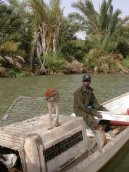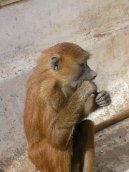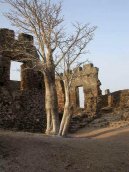| Introduction - Gambia, The: |
Country | Gambia, The |
|
Background | The Gambia gained its independence from the UK in 1965. Geographically surrounded by Senegal, it formed a short-lived federation of Senegambia between 1982 and 1989. In 1991 the two nations signed a friendship and cooperation treaty, but tensions have flared up intermittently since then. Yahya A. J. J. JAMMEH led a military coup in 1994 that overthrew the president and banned political activity. A new constitution and presidential elections in 1996, followed by parliamentary balloting in 1997, completed a nominal return to civilian rule. JAMMEH has been elected president in all subsequent elections, including most recently in late 2006. |
|
|
|
| Location - Gambia, The: |
Location | Western Africa, bordering the North Atlantic Ocean and Senegal |
|
Geographic coordinates | 13 28 N, 16 34 W |
|
Map references | Africa |
|
Area | total: 11,300 sq km
land: 10,000 sq km
water: 1,300 sq km |
|
Area comparative | slightly less than twice the size of Delaware |
|
Land boundaries | total: 740 km
border countries: Senegal 740 km |
|
Coastline | 80 km |
|
Maritime claims | territorial sea: 12 nm
contiguous zone: 18 nm
exclusive fishing zone: 200 nm
continental shelf: extent not specified |
|
Climate | tropical; hot, rainy season (June to November); cooler, dry season (November to May) |
|
Terrain | flood plain of the Gambia River flanked by some low hills |
|
Elevation extremes | lowest point: Atlantic Ocean 0 m
highest point: unnamed location 53 m |
|
Natural resources | fish, titanium (rutile and ilmenite), tin, zircon, silica sand, clay, petroleum |
|
Land use | arable land: 27.88%
permanent crops: 0.44%
other: 71.68% (2005) |
|
Irrigated land | 20 sq km (2003) |
|
Natural hazards | drought (rainfall has dropped by 30% in the last 30 years) |
|
Environment current issues | deforestation; desertification; water-borne diseases prevalent |
|
Environment international agreements | party to: Biodiversity, Climate Change, Climate Change-Kyoto Protocol, Desertification, Endangered Species, Hazardous Wastes, Law of the Sea, Ozone Layer Protection, Ship Pollution, Wetlands, Whaling
signed, but not ratified: none of the selected agreements |
|
Geography note | almost an enclave of Senegal; smallest country on the continent of Africa |
|
| People - Gambia, The: |
Population | 1,688,359 (July 2007 est.) |
|
Age structure | 0-14 years: 44.1% (male 373,831/female 370,397)
15-64 years: 53.2% (male 445,365/female 452,311)
65 years and over: 2.8% (male 23,582/female 22,873) (2007 est.) |
|
Median age | total: 17.8 years
male: 17.6 years
female: 17.9 years (2007 est.) |
|
Population growth rate | 2.781% (2007 est.) |
|
Birth rate | 38.86 births/1,000 population (2007 est.) |
|
Death rate | 11.99 deaths/1,000 population (2007 est.) |
|
Net migration rate | 0.94 migrant(s)/1,000 population (2007 est.) |
|
Sex ratio | at birth: 1.03 male(s)/female
under 15 years: 1.009 male(s)/female
15-64 years: 0.985 male(s)/female
65 years and over: 1.031 male(s)/female
total population: 0.997 male(s)/female (2007 est.) |
|
Infant mortality rate | total: 70.14 deaths/1,000 live births
male: 76.55 deaths/1,000 live births
female: 63.54 deaths/1,000 live births (2007 est.) |
|
Life expectancy at birth | total population: 54.54 years
male: 52.68 years
female: 56.46 years (2007 est.) |
|
Total fertility rate | 5.21 children born/woman (2007 est.) |
|
Hiv aids adult prevalence rate | 1.2% (2003 est.) |
|
Hiv aids people living with hiv aids | 6,800 (2003 est.) |
|
Hiv aids deaths | 600 (2003 est.) |
|
Nationality | noun: Gambian(s)
adjective: Gambian |
|
Major infectious diseases | degree of risk: very high
food or waterborne diseases: bacterial and protozoal diarrhea, hepatitis A, and typhoid fever
vectorborne diseases: dengue fever, malaria, Crimean-Congo hemorrhagic fever, yellow fever are high risks in some locations
water contact disease: schistosomiasis
respiratory disease: meningococcal meningitis (2007) |
|
Ethnic groups | African 99% (Mandinka 42%, Fula 18%, Wolof 16%, Jola 10%, Serahuli 9%, other 4%), non-African 1% |
|
Religions | Muslim 90%, Christian 9%, indigenous beliefs 1% |
|
Languages | English (official), Mandinka, Wolof, Fula, other indigenous vernaculars |
|
Literacy | definition: age 15 and over can read and write
total population: 40.1%
male: 47.8%
female: 32.8% (2003 est.) |
|
| Government - Gambia, The: |
Country name | conventional long form: Republic of The Gambia
conventional short form: The Gambia |
|
Government type | republic |
|
Capital | name: Banjul
geographic coordinates: 13 27 N, 16 34 W
time difference: UTC 0 (5 hours ahead of Washington, DC during Standard Time) |
|
Administrative divisions | 5 divisions and 1 city*; Banjul*, Central River, Lower River, North Bank, Upper River, Western |
|
Independence | 18 February 1965 (from UK) |
|
National holiday | Independence Day, 18 February (1965) |
|
Constitution | approved by national referendum 8 August 1996; effective 16 January 1997 |
|
Legal system | based on a composite of English common law, Islamic law, and customary law; accepts compulsory ICJ jurisdiction with reservations |
|
Suffrage | 18 years of age; universal |
|
Executive branch | chief of state: President Yahya A. J. J. JAMMEH (since 18 October 1996); note - from 1994 to 1996 he was chairman of the Junta; Vice President Isatou NJIE-SAIDY (since 20 March 1997); note - the president is both the chief of state and head of government
head of government: President Yahya A. J. J. JAMMEH (since 18 October 1996); Vice President Isatou NJIE-SAIDY (since 20 March 1997)
cabinet: Cabinet appointed by the president
elections: president elected by popular vote for a five-year term (no term limits); election last held 22 September 2006 (next to be held in 2011)
election results: Yahya A. J. J. JAMMEH reelected president; percent of vote - Yahya A. J. J. JAMMEH 67.3%, Ousainou DARBOE 26.6%, Halifa SALLAH 6.0% |
|
Legislative branch | unicameral National Assembly (53 seats; 48 members elected by popular vote, 5 appointed by the president; to serve five-year terms)
elections: last held 25 January 2007 (next to be held in 2012)
election results: percent of vote by party - NA; seats by party - APRC 47, UDP 4, NADD 1, independent 1 |
|
Judicial branch | Supreme Court |
|
Political parties and leaders | Alliance for Patriotic Reorientation and Construction or APRC (the ruling party) [Yahya A. J. J. JAMMEH]; Gambia Peoples Democratic Party or GPDP [Henry GOMEZ]; National Alliance for Democracy and Development or NADD [Halifa SALLAH]; National Convention Party or NCP [Sheriff DIBBA]; National Reconciliation Party or NRP [Hamat N. K. BAH]; Peoples Democratic Organization for Independence and Socialism or PDOIS [Sidia JATTA]; United Democratic Party or UDP [Ousainou DARBOE] |
|
Political pressure groups and leaders | NA |
|
International organization participation | ACP, AfDB, AU, C, ECOWAS, FAO, G-77, IBRD, ICAO, ICCt, ICRM, IDA, IDB, IFAD, IFC, IFRCS, ILO, IMF, IMO, Interpol, IOC, IOM, IPU, ITSO, ITU, ITUC, MIGA, NAM, OIC, ONUB, OPCW, UN, UNCTAD, UNESCO, UNIDO, UNMIL, UNOCI, UNWTO, UPU, WCL, WCO, WFTU, WHO, WIPO, WMO, WTO |
|
Diplomatic representation in the us | chief of mission: Ambassador Dodou Bammy JAGNE
chancery: Suite 905, 1156 15th Street NW, Washington, DC 20005
telephone: [1] (202) 785-1379
FAX: [1] (202) 785-1430 |
|
Diplomatic representation from the us | chief of mission: Ambassador Joseph D. STAFFORD, III
embassy: Kairaba Avenue, Fajara, Banjul
mailing address: P. M. B. No. 19, Banjul
telephone: [220] 439-2856, 437-6169, 437-6170
FAX: [220] 439-2475 |
|
Flag description | three equal horizontal bands of red (top), blue with white edges, and green |
|
| Economy - Gambia, The: |
Economy overview | The Gambia has no confirmed mineral or natural resource deposits and has a limited agricultural base. About 75% of the population depends on crops and livestock for its livelihood. Small-scale manufacturing activity features the processing of peanuts, fish, and hides. Reexport trade normally constitutes a major segment of economic activity, but a 1999 government-imposed preshipment inspection plan, and instability of the Gambian dalasi (currency) have drawn some of the reexport trade away from The Gambia. The Gambias natural beauty and proximity to Europe has made it one of the larger markets for tourism in West Africa. The governments 1998 seizure of the private peanut firm Alimenta eliminated the largest purchaser of Gambian groundnuts. Despite an announced program to begin privatizing key parastatals, no plans have been made public that would indicate that the government intends to follow through on its promises. Unemployment and underemployment rates remain extremely high; short-run economic progress depends on sustained bilateral and multilateral aid, on responsible government economic management, on continued technical assistance from the IMF and bilateral donors, and on expected growth in the construction sector. |
|
Gdp purchasing power parity | $3.284 billion (2006 est.) |
|
Gdp official exchange rate | $462.5 million (2006 est.) |
|
Gdp real growth rate | 5.3% (2006 est.) |
|
Gdp per capita ppp | $2,000 (2006 est.) |
|
Gdp composition by sector | agriculture: 30.5%
industry: 13.9%
services: 55.6% (2006 est.) |
|
Labor force | 400,000 (1996) |
|
Labor force by occupation | agriculture: 75%
industry: 19%
services: 6% |
|
Unemployment rate | NA% |
|
Population below poverty line | NA% |
|
Household income or consumption by percentage share | lowest 10%: NA%
highest 10%: NA% |
|
Inflation rate consumer prices | 14% (2006 est.) |
|
Investment gross fixed | 20.3% of GDP (2006 est.) |
|
Budget | revenues: $112.7 million
expenditures: $155.1 million; including capital expenditures of $4.1 million (2006 est.) |
|
Agriculture products | rice, millet, sorghum, peanuts, corn, sesame, cassava (tapioca), palm kernels; cattle, sheep, goats |
|
Industries | processing peanuts, fish, and hides; tourism, beverages, agricultural machinery assembly, woodworking, metalworking, clothing |
|
Industrial production growth rate | NA% |
|
Electricity production | 145 million kWh (2004) |
|
Electricity consumption | 134.9 million kWh (2004) |
|
Electricity exports | 0 kWh (2004) |
|
Electricity imports | 0 kWh (2004) |
|
Oil production | 0 bbl/day (2004 est.) |
|
Oil consumption | 2,000 bbl/day (2004 est.) |
|
Oil exports | NA bbl/day |
|
Oil imports | NA bbl/day |
|
Oil proved reserves | 0 bbl |
|
Natural gas production | 0 cu m (2004 est.) |
|
Natural gas consumption | 0 cu m (2004 est.) |
|
Current account balance | -$54.61 million (2006 est.) |
|
Exports | $130.5 million f.o.b. (2006 est.) |
|
Exports commodities | peanut products, fish, cotton lint, palm kernels, re-exports |
|
Exports partners | India 36.8%, UK 15.1%, Indonesia 7.5%, France 6.8%, Italy 4.3%, Senegal 4.2% (2006) |
|
Imports | $212.2 million f.o.b. (2006 est.) |
|
Imports commodities | foodstuffs, manufactures, fuel, machinery and transport equipment |
|
Imports partners | China 25%, Senegal 12.6%, Cote dIvoire 8%, Brazil 6.2%, Netherlands 4.4% (2006) |
|
Reserves of foreign exchange and gold | $88.11 million (2006 est.) |
|
Debt external | $628.8 million (2003 est.) |
|
Economic aid recipient | $59.8 million (2003) |
|
Currency code | dalasi (GMD) |
|
Exchange rates | dalasi per US dollar - 28.3 (2006), 30.38 (2005), 30.03 (2004), 27.306 (2004), 19.918 (2003), 15.687 (2002), 15.687 (2001) |
|
| Communications - Gambia, The: |
Fiscal year | calendar year |
|
Telephones main lines in use | 52,900 (2006) |
|
Telephones mobile cellular | 404,300 (2006) |
|
Telephone system | general assessment: adequate; a packet switched data network is available
domestic: adequate network of microwave radio relay and open-wire
international: country code - 220; microwave radio relay links to Senegal and Guinea-Bissau; satellite earth station - 1 Intelsat (Atlantic Ocean) (1997) |
|
Radio broadcast stations | AM 3, FM 2, shortwave 0 (2001) |
|
Television broadcast stations | 1 (government-owned) (1997) |
|
Internet country code | .gm |
|
Internet hosts | 14 (2006) |
|
Internet users | 58,000 (2005) |
|
| Transportation - Gambia, The: |
Airports | 1 (2006) |
|
Airports with paved runways | total: 1
over 3,047 m: 1 (2006) |
|
Roadways | total: 3,742 km
paved: 723 km
unpaved: 3,019 km (2004) |
|
Waterways | 390 km (on River Gambia; small ocean-going vessels can reach 190 km) (2006) |
|
Merchant marine | total: 5 ships (1000 GRT or over) 32,064 GRT/9,751 DWT
by type: passenger/cargo 4, petroleum tanker 1 (2006) |
|
Ports and terminals | Banjul |
|
| Military - Gambia, The: |
Military branches | Gambian National Army (GNA), Gambian Navy (GN), Gambian National Guard (includes Presidential Guard) (2007) |
|
Military service age and obligation | 18 years of age for voluntary military service; no conscription (2001) |
|
Manpower available for military service | males age 18-49: 311,025
females age 18-49: 316,214 (2005 est.) |
|
Manpower fit for military service | males age 18-49: 183,057
females age 18-49: 194,551 (2005 est.) |
|
Military expenditures percent of gdp | 0.5% (2006) |
|
Disputes international | attempts to stem refugees, cross-border raids, arms smuggling, and other illegal activities by separatists from southern Senegals Casamance region, as well as from conflicts in other west African states |
|
This page was last updated on 16 September, 2007



